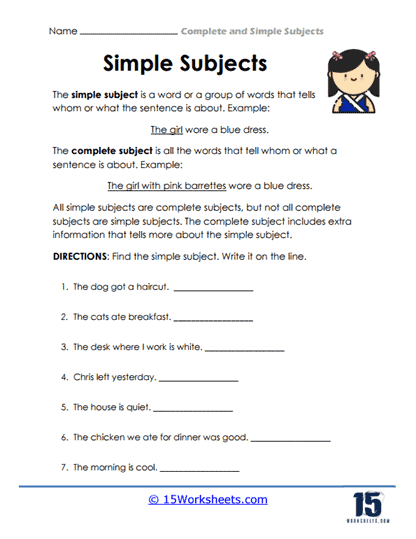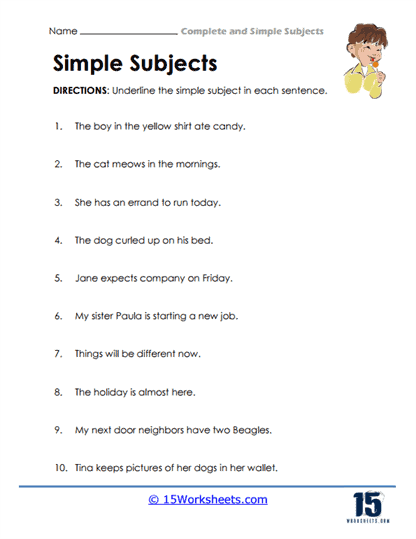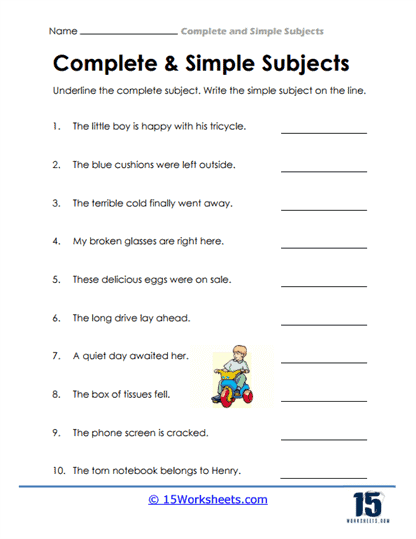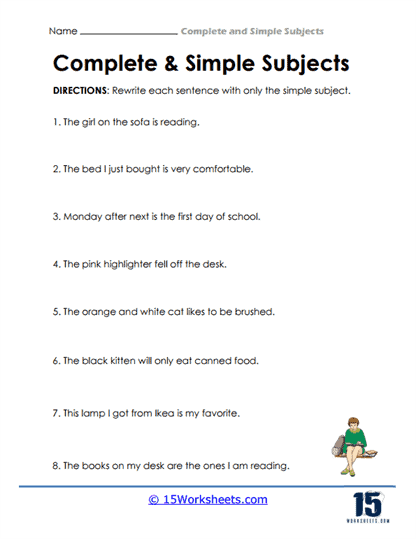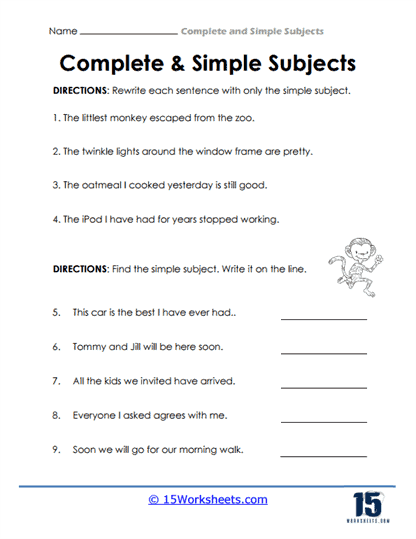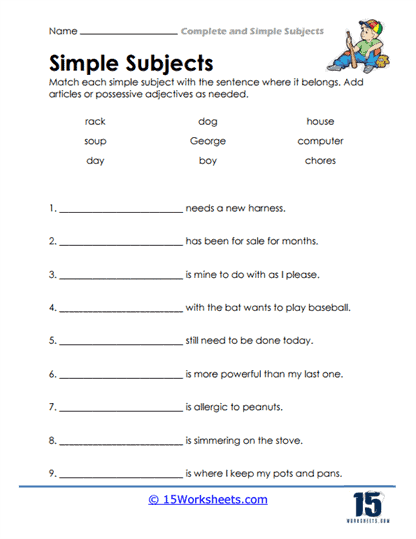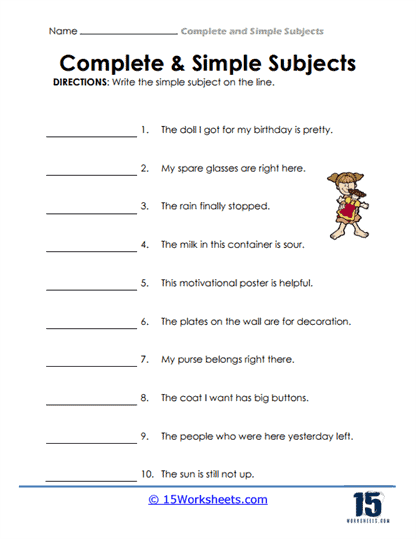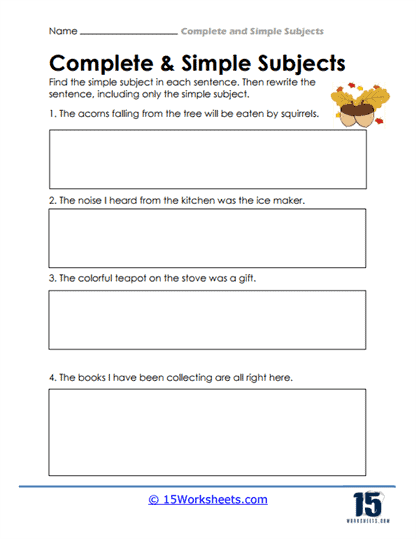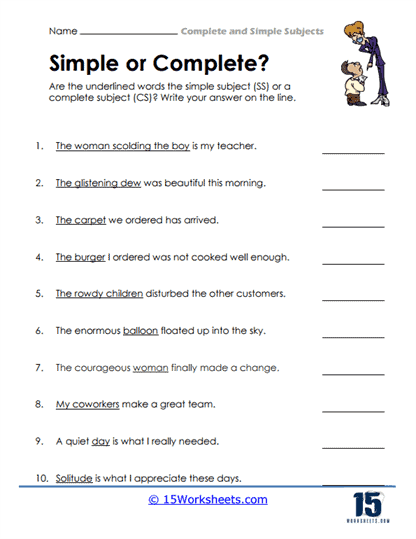Complete and Simple Subjects Worksheets
All About These 15 Worksheets
This magical collection of worksheets is here to help students master the mysterious world of complete and simple subjects without pulling their hair out (or yours). Whether you’re a teacher trying to explain why “the very fluffy orange cat on the windowsill” is a complete subject, or a student wondering why English insists on being weird, you’ve come to the right place. These worksheets turn sentence dissection into a low-stress brain workout-with only minimal chances of dramatic sighing.
From underlining the subject like a detective (“Underline It!“), to sorting them out like laundry that actually matters (“Sorting Challenge“), these activities are designed to keep students engaged, thinking, and maybe even laughing. You’ll rewrite, simplify, circle, and probably question your life choices somewhere around “Sentence Mash-Up.” But don’t worry-it’s all part of the grammatical glow-up. Get ready to turn students into subject-spotting superheroes, one worksheet at a time. Capes optional.
A Look At the Individual Worksheets
The odyssey begins with “Find And Write,” a deceptively simple task where students must identify the subject in a sentence. It’s like a game of hide-and-seek, but the subjects are particularly good at hiding behind prepositional phrases. “Underline It” and “On The Line” follow, challenging students to not only find the subject but also to underline it with the precision of a surgeon and the flair of a calligrapher. “Simply Rewrite” asks students to take sentences and, well, rewrite them simply-because nothing says fun like rephrasing sentences until they lose all meaning.
As the journey continues, “Sentence Mash-Up” throws a curveball by mixing up sentences like a linguistic smoothie, leaving students to separate the subjects from the predicates. “Only The Simple” focuses on identifying the simple subject, stripping away all the modifiers like peeling an onion-tears included. “Add As Needed” flips the script, requiring students to add subjects to incomplete sentences, effectively playing Dr. Frankenstein with grammar.
Midway through, “Look For It” and “Sorting Challenge” test students’ abilities to distinguish between complete and simple subjects, sorting them with the efficiency of a librarian on a caffeine high. “Simplify It” demands the reduction of complex subjects to their simplest forms, a task that would make even Marie Kondo proud. “SS or CS?” (Simple Subject or Complete Subject?) is the ultimate identity crisis, forcing students to label subjects correctly or face the wrath of the grammar gods.
In the final stretch, “Lines And Circles” turns grammar into an art project, having students draw lines and circles around subjects like a modern-day Da Vinci. “Complete To Simple” challenges students to distill complete subjects into their simple counterparts, a task akin to turning a triple espresso into a single shot. “Writing Sentences” and “About Each Picture” culminate the journey by having students craft their own sentences based on images, proving they can not only identify subjects but also create them-a true sign of mastery.
What is the Difference Between Simple and Complete Subjects?
Simple Subject
The simple subject is the main word or word group in the complete subject. It’s typically a noun or a pronoun that the sentence is “about”. It doesn’t include any of the modifiers or additional details associated with it.
Examples:
“Dogs are loyal pets.” (Simple subject is “Dogs”)
“The small, nervous kitten hid under the bed.” (Simple subject is “kitten”)
“A group of excited children were playing in the park.” (Simple subject is “group”)
Complete Subject
The complete subject includes the simple subject and all the words that modify or describe it. It can include adjectives, article adjectives (a, an, the), and other words or phrases that provide additional information about the simple subject.
Examples:
“Dogs are loyal pets.” (Complete subject is “Dogs”)
“The small, nervous kitten hid under the bed.” (Complete subject is “The small, nervous kitten”)
“A group of excited children were playing in the park.” (Complete subject is “A group of excited children”)

